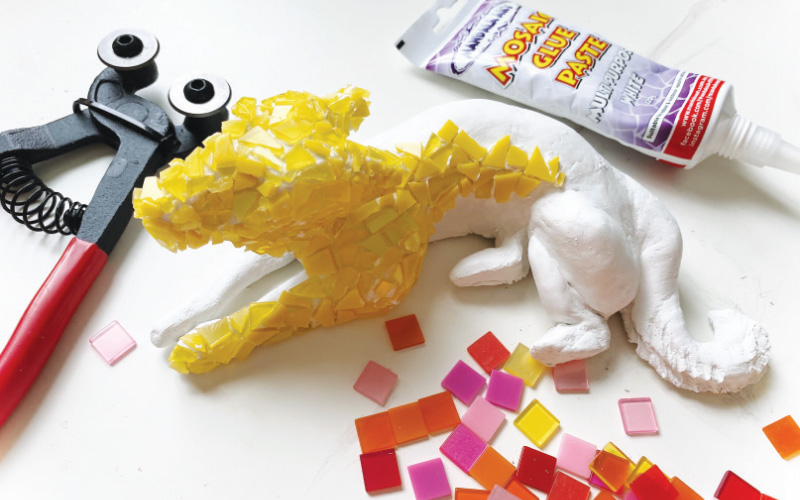Mosaic lesson
Suitable for: F-6, Visual Arts, Aboriginal and Torres Strait Islander Histories and Cultures, Science, HSIE

Click Here to download Lesson Plan
Overview
Students will explore the scientific, historic and cultural aspects associated with dingoes. Using the influences of Lin Onus’ sculptural installation ‘Dingoes’ (1989) and Danie Mellor’s ‘Native Gold’ (2008) students will create drawings leading to a design and final sculpture of a dingo made from clay and mosaic glass. For lower primary, we recommend using Paper Magiclay, which can be decorated with markers, paint, paper or sequins.
Outcomes/Indicators
ACAVAM106/ACAVAM110/ACAVAM114 – Students respond to the practice of Lin Onus and Danie Mellor, using their works to influence ideas, subject matter, style and materials within their own representations.
ACAVAM107/ACAVAM111/ACAVAM115 – Students experiment with a range of mark making, sculptural and decorative techniques throughout the process of developing a resolved artwork.
Suggested Steps
Step 1: Students explore topics associated with dingoes including their features, behaviour, diet, habitat, migration to Australia, importance in First Nations culture and the dingo fence.
Step 2: Students are introduced to Lin Onus’ ‘Dingoes’ where they practise drawing the characters, as well as additional reference images, using a variety of materials. Students can create a personality profile of their dingo and a drawing or painting of it’s habitat.
Step 3: Students choose one drawing as a design for their sculpture, adding a pattern or colour where mosaic glass could be placed. Teachers should provide a demonstration of hand modelling and using clay tools before students begin constructing their clay works.
Step 4: After the clay has been smoothed and set to dry, students attach mosaic glass to the sculpture using an appropriate adhesive. Any shape variations to the glass should be pre-cut by the teacher. The teacher may choose to use only one colour, similar to the practice of Mellor, or students may experiment arranging hues and patterns as a reference to the dingo’s coat or the landscape.
Step 5: Once dried, students use grout and water, mixed at a toothpaste consistency, to ensure the mosaic pieces remain in place.
Materials & Equipment
- GA004-AS – Glass Mosaic Tiles – Assorted Mini
- GA012-WH – Grout 5kg
- GA014 – Mosaic Glue Paste
- ML130 – Clay Tool Kit
- ML285 – Magiclay White
- ML296 – Magiclay Earth Colours
- ML712 – Oz Clay 2kg
- PA106 – Cartridge paper A4 130gsm
- PA912 – BioGone Cling Wrap 600m
- PL100-WH – Plastic Sheeting 1.5m
- PM443 – Zart Multi Pen Set 3pk
- PN172 – Triangular Coloured Pencils 24pk
- PS038- Large Oil Pastels 24pk
- SM326 – Sequins
- SM600-EA – Deco Mosaic Tiles – Earth
Share Your Outcomes!
How did you go!? We’d love you to share your artwork with us on Facebook or Instagram!
#zartart

